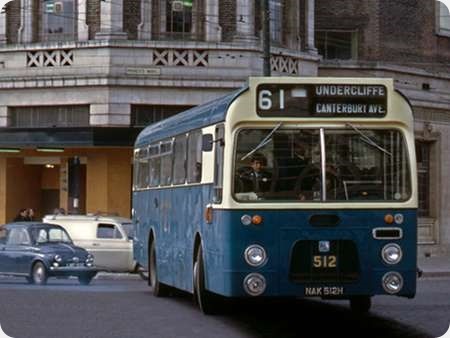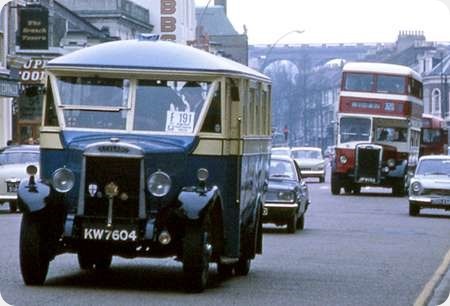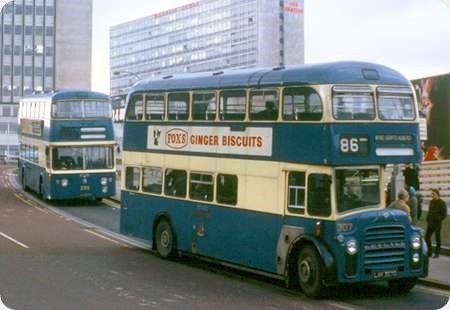
Bradford Corporation Transport
1969
Leyland Panther PSUR1A/1
Marshall B45D
For 1969, Bradford Corporation ordered ten chassis of the rear horizontal engine variety, its first new single deckers since a couple of AEC Reliances in 1958. The ten new chassis were split between AEC’s Swift and Leyland’s Panther, but, since the chassis design of the two types was virtually identical apart from the engine manufacture and the radiator position – at the rear on the AEC and at the front on the Leyland – the exercise was probably intended to ascertain which power unit was best suited to the challenging Bradford terrain. All ten were equipped with Marshall B45D bodies. Seen above in April 1970 is the last of the batch, No. 512, NAK 512H which was delivered in December 1969. In the event, no further single deckers were to be bought by Bradford before the infliction upon all the West Yorkshire municipalities from 1st April 1974 of the all embracing WYPTE. In this new conglomeration, the five Bradford Panthers were the only examples of their type, and the PTE Director of Engineering, a certain Geoffrey Hilditch, soon sold them all to Chesterfield. A picture of one in service in that town may be seen here (a very long page, but about halfway down – search for Chesterfield in the browser :- www.mikesbuspages.com/municipalbuses.htm
In his book Steel Wheels and Rubber Tyres, GGH says that pictures of the Bradford Panthers in original livery are hard to come by – he should have asked me.
Photograph and Copy contributed by Roger Cox
11/09/17 – 06:38
Nice pic!
Stuart Emmet Another story on these 10 was they were bought to start OMO; however double decker OMO was approved legally soon after they were ordered, so they were redundant as far as that went. They spent their time inventing conversions to single decker routes and seemed to settle on the 61 as shown – about a 25-minute journey across town from Undercliffe to St. Enochs that went for around 5 mins over roads in the Canterbury Ave area that were not used by other routes.Effectively a peak hour route every 10 min from 0700 to 0900 and 1600 to 1800 with a few journeys between 1200 & 1400 hours that required 6 buses for the 10-minute headway. The rest of time they seemed to rest/in-filled as spares.
Stuart Emmet
12/09/17 – 06:46
From 1969, BCT participated in White Rose Express service X33, Bradford – Sheffield, which entered its area at Birkenshaw. The other joint operators reluctantly agreed, even though Bradford’s entitlement was no more than one journey per week! In practice, as explained to me by the late Stanley King, Bradford saved up their mileage until they were able to operate a bus for a whole week, replacing a Yorkshire Woollen duty.
BCT had few single deckers and I believe these Panthers and the contemporary Swifts were used. Does anyone recall seeing a photo of a Bradford bus on X33, as I’ve never seen one.
Geoff Kerr
12/09/17 – 06:47
Just about everyone was caught with the change of legislation which allowed DD OMO. Sheffield certainly was – initially with purchase of the Swifts and subsequently with the change of Bristol order from REs to VRs.
David Oldfield
13/09/17 – 06:46
In the lovely book Colours of West Yorkshire the author states that these were ordered because agreement could not be reached with the Unions to operate OMO double deckers. I.e. The legislation already permitted it but not the Unions until agreement was reached later on.
Sam Caunt
14/09/17 – 07:04
The Bradford manager at the time was not in favour of one man buses These and the Swifts were also used on the express X72 which ran between Bradford and Leeds at peak hours.
Chris Hough
15/09/17 – 06:45
I recall someone (who I believe was very knowledgeable) telling me that as late as 1981/2 that Bradford area buses of West Yorkshire PTE were around 80% crew operated.
Dave Towers
16/09/17 – 06:47
The change in legislation to permit double deck OPO was in 1966, and I doubt that an order for vehicles to be delivered in 1969 had been placed before that date – i.e. the fact that D/D OPO was possible would have been known.
I like to see a clear and readable destination display, but in this case I suspect that a slightly smaller window would have fitted the lines of the vehicle rather better!
Nigel Frampton
17/09/17 – 06:55
Another story was that the unions rejected the DD legislation but SD would be OK It was also said on delivery of these SD’s unions OKed the use of DD OMO How far this any of this is fact or fiction seems lost in time.
Stuart Emmet
18/09/17 – 07:19
I started working at Bradford City Transport in the Traffic Office in October 1973. The story of OMO at BCT is intriguing. I cannot comment on the position of General Manager Edward Deakin in relation to OMO, although I could find out as Bob Tidswell his PA is still heal and hearty. I can say that Traffic Superintendent John Hill was not very enthusiastic about OMO, and from all accounts the T&GWU branch was not very keen, either. Around 1971 or 1972 the position of Asst. Traffic Superintendent became vacant and Brian Eastwood, who was Traffic Superintendent at Maidstone Corporation, was appointed to the post. Maidstone had undertaken extensive conversion to OMO and BCT felt that Brian’s experience in this regard would be extremely useful. Many years later Brian told me that when he arrived at Forster Square – BCT Head Office – there was little enthusiasm for OMO. Earlier this year I had lunch with Brian and he said that many of the new ideas that he tried to bring to Bradford fell on stony ground. Maidstone had a very large circle OMO sign on the front of their Atlanteans and Brian arranged for one of the signs to be sent to Bradford for evaluation. John Hill rejected the idea. Bob Tidswell once told me that Edward Deakin had a policy of splitting chassis orders between manufacturers – and thus having small batches – on the basis that if one chassis type developed a serious fault then the impact on the operational fleet would be minimised. Some of the single-deckers were allocated to Ludlam Steet and were used on the 272 service to Leeds, the 61 and sometimes other routes operated from the depot, such as Eccleshill, Fagley and Haworth Road. They were used on the White Rose service and at weekends for private hire work at weddings etc. When the PTE was formed John Hill became Metro Bradford District Manager and the position of District Traffic Officer was given to Bert Henry from Leeds City Transport who was very keen to expand OMO across the Bradford route network.
Kevin Hey
19/09/17 – 06:01
Still trying to get "facts" and the best come across so far, is from the JS King book. The following is a timeline summary:
1967
BCT ordered the Swifts and Panthers (503-512 ) to start OMO and had the unions OK 8 and 10/1969. The Swifts and Panthers arrived but went to work with conductors on 61, 83 and 27-29/32. Cannot find a reason why they were not used for OMO. These buses were also available for breakdown cover for the other operators on the joint with 7 other operators "White Rose" express to Sheffield; BCT having only one journey a week which they "banked" so they could then a bus operate all week.
Mr King notes the SD were already "white elephants", as by now DD OMO was acceptable, so seventy 33 foot DD were ordered, with union acceptance of OMO for these 2 door 33 foot vehicles.
8/1970
The DD start to arrive (401-470) but unions said no as are too long and the drivers’ view of exit door was insufficient. So OMO introduction postponed once again.
9/1971
SD work on the peak time only Leeds express (272) joint with Leeds CT who operated SD OMO, but BCT used conductors
31 Dec 1972
OMO finally starts using 30 foot DD (315 to 355) on routes 36-38 and 40-42 20 May 1973
OMO starts on joint working with Leeds on the 72 route
Footnote
This appears is a strange story, that however, shows the management/union environment at the time.
Stuart Emmet
19/09/17 – 06:02
Re Kevin Heys comments. There was a regular evening trip on service 46 to Buttershaw.
OMP operation commenced in Bradford with the conversion of the 72/78 services between Bradford and Leeds which were jointly operated with Leeds City Transport. This started in late May 1973. I cannot recall them being used on White Rose services during my time in Bradford in 1973.
Stephen Bloomfield
22/09/17 – 07:15
I suspect that when BCT ordered dual doorway buses the ‘agreement’ with the T&GWU was merely one of outline or agreement in principle to discuss the matter. It would appear that a detailed agreement with signatories was not secured until 1972. The initial conversions at the end of 1972 used single door Fleetlines, but evidently the T&GWU was prepared to allow two-door buses to be used on services to Leeds when these were converted in May 1973. The feeling I detected at Bradford was that neither management nor the T&GWU were keen to pursue OMO. Management believed that OMO made the service worse for passengers, while the T&GWU was against a reduction in potential members and staff – members – losing overtime.
Kevin Hey
21/11/17 – 08:30
Just a reminder that the 5 Panthers transferred to Calderdale in early PTE days. There was a serious blind spot problem with the blank front corners and all were modified with small corner windows. Memory fails me but I wonder if a serious/fatal accident blamed on lack of visibility occurred. I recall that these weren’t bad buses, hadn’t done a lot of mileage with Bradford.The biggest problem was (the lack of) pit length and accessibility with 36′ long buses in the Dock Shop at Skircoat Road. They were also a bit limited on allocation because of road/junction/camber problems on many routes. Someone out there will remind me how long they ran in Halifax prior to sale to Chesterfield where they put in a good number of years service.
Ian Wild
22/11/17 – 07:22
The first of the Bradford Panthers to arrive in Halifax was 2511 in October 1974, followed by 2508/10/12 in November and 2509 in December – all still in BCT blue and cream livery. They were allocated solely to the 5/6 West End Circular route, which required four vehicles during the daytime just going endlessly round and round, so presumably the fifth one was usually either parked up or ‘day in’ for maintenance. I don’t think the trade union would allow them to be used on any other route – I certainly don’t remember seeing them anywhere else.
Unfortunately one of them was involved in a fatal accident when operating a 6 (clockwise) journey and turning right from Heath Road into Free School Lane – just a couple of hundred yards from Skircoat Garage. They had very thick front corner pillars which caused a terrible blind spot for the driver. The bus had begun to take the right turn and was not cutting the corner when a young chap on a moped approached from the right and appeared to stop at the junction with the intention of going straight ahead after the bus had turned. However he must have decided to chance it and accelerated across the front of the bus, but due to the blind spot the driver couldn’t see him and a terrible accident ensued in which the lad was killed. The bus driver was shown to have been blameless.
The five were immediately taken off the road and, as Ian says, small (very small) windows were let into the pillars. My records only show that they were withdrawn during 1975, but that they passed to Chesterfield Corporation in the September. They ran them quite successfully until 1985/86 after which they saw even further service with CityBus in Manchester.
John Stringer
24/11/17 – 07:23
That sounded a terrible, tragic accident indeed for all concerned John, and it still amazes me that in this day and age just how many modern cars have quite serious blindspots, especially to the rear. West Yorkshire had a 1964 Bristol RELH6G express coach (ERG1/1001: AWR 401B) refurbished by Willowbrook in 1977, which included a new peaked front dome, Duple-type windscreen and revised front dash panel, grille and headlamps. On return to West Yorkshire, and before re-entry into service, the Duple screen was removed and the original ECW ‘wrap around’ version reinstated. This was not connected with night-time reflections as is often stated, but due to a serious blind spot either side of the windscreen. The Duple screen had curved sides, which on a Duple (or Plaxton) body would not have been a problem, as the body pillars/sides were also curved and therefore matched. The ECW body had straight pillars/sides, but the curved Duple screen was matched up to the front pillars using an infill panel at either side, which flared out towards the top. The local ‘Man from the Ministry’ would not pass the vehicle as he felt the blind spots were a serious hazard, hence the change back to original spec. We’ll never know, but the thoroughness of that Ministry Inspector may well have prevented a serious accident at some point, and even saved a life, for which we should be very thankful.
Brendan Smith
29/12/17 – 07:47
The reference to the Panthers being used on the White Rose appeared in a recent book- though I couldn’t find the reference when I looked for it, inevitably. I moved to Sheffield in 1969 and used the X33 regularly but never saw or heard of Bradford actually working on the White Rose; more significantly no record of such a working ever appeared in local enthusiast publications of the time and I never heard fellow enthusiasts mention it.’Joint operation in South Yorkshire’, published by the Omnibus Society in 1974, is also silent on the issue, despite mentioning that, for instance, Ribble provided duplicates on Yorkshire Traction’s X19 (Manchester-Barnsley). It would be intersting if anyone can produce chapter and verse on Bradford’s involvement.
Phil Drake
29/12/17 – 09:48
There was mention somewhere to the effect that the Bradford share, based on the miles of the route in Bradford, was small, therefore Bradford saved up the miles which meant something strange like one bus every x weeks or similar. Will try and find the reference for you. Additionally, Brasford was able to provide breakdown cover for any buses having issues.
Stuart Emmett
30/12/17 – 08:46
Extracts from J S King (1995) Bradford Corporation Motorbuses pages 99 and 100. John King (RIP) is the acknowledged expert on all matters Bradford (trams, trolleys and buses).
Mexborough & Swinton had proposed a network of routes along the then new M1. A consortium of interested parties was formed with M&S, Sheffield JOC, Rotherham, YWD, YTC, WR and Hebble and a service from Sheffield to Bradford via Dewsbury was agreed.
On hearing of this Bradford applied and got consent but as the route in Bradford was less than 10% of the whole giving one journey a week, Bradford decided to accumulated mileage until there had enough for one bus for one week when they took over a YWD duty.
Sheffield, Barnsley and Mexborough were to now appear on all future Bradford buses, meanwhile, 505 to 512 were made available and were occasionally used.
A trial run by Bradford took place on the 14th October 1969 and service started four days later.
Stuart Emmett
08/01/18 – 07:21
Sorry about the delayed reply, but thanks to John Stringer for details of the fatal accident with one of the Panthers whilst in Halifax. It makes you wonder how they ever got through initial certification, I’m almost certain the blind spot would never have been accepted by the Yorkshire TA Certifying Officers. I recall a couple of Halifax Leopard/Weymann buses being ‘overhauled’ as an emergency measure by Willowbrook. They came back with new 6 year certificates (12/13 year old buses by this time) with far less work than we had to put in to obtain a grudging 5 years. This difference in standards in different Traffic Areas continued up to the day I retired!
Ian Wild



